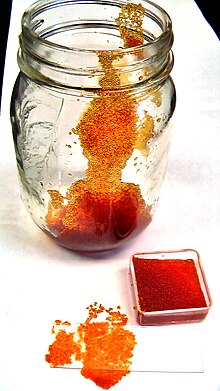
An ion-exchange resin or ion-exchange polymer is a resin or polymer that acts as a medium for ion exchange, that is also known as an ionex.[1] It is an insoluble matrix (or support structure) normally in the form of small (0.25–1.43 mm radius) microbeads, usually white or yellowish, fabricated from an organic polymer substrate. The beads are typically porous (with a specific size distribution that will affect its properties), providing a large surface area on and inside them where the trapping of ions occurs along with the accompanying release of other ions, and thus the process is called ion exchange. There are multiple types of ion-exchange resin, that differ in composition if the target is an anion or a cation. Most commercial resins are made of polystyrene sulfonate,[2] followed up by polyacrylate.[3]

Ion-exchange resins are widely used in different separation, purification, and decontamination processes. The most common examples are water softening and water purification. In many cases, ion-exchange resins were introduced in such processes as a more flexible alternative to the use of natural or artificial zeolites. Also, ion-exchange resins are highly effective in the biodiesel filtration process.
- ^ Matsuda, K.; Oka, T.; Tani, T.; Hanasawa, K.; Yoshioka, T.; Aoki, H.; Endo, Y.; Ishii, Y.; Numa, K.; Kodama, M. (1989-12-01). "Experimental study on the adsorption of excess heparin with anion exchange resin fiber". Artificial Organs. 13 (6): 504–507. doi:10.1111/j.1525-1594.1989.tb01570.x. ISSN 0160-564X. PMID 2604592.
- ^ François Dardel and Thomas V. Arden "Ion Exchangers" in Ullmann's Encyclopedia of Industrial Chemistry, 2008, Wiley-VCH, Weinheim. doi:10.1002/14356007.a14_393.pub2.
- ^ "Ion Exchange (IX) |Water Solutions". www.dupont.com. Retrieved 2023-05-21.